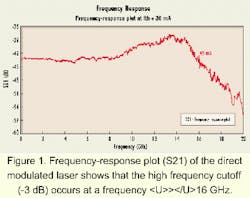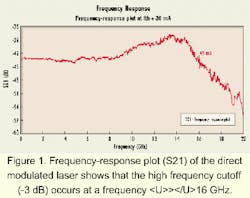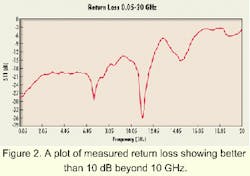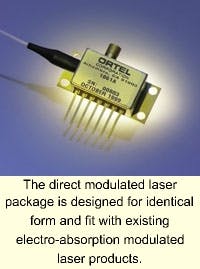Direct laser modulation at rates over 10 Gbits/sec
Ramzi Sawires Ortel Corp.
The expected explosive growth of OC-192 applications is putting increasing demand on component suppliers to develop new products capable of delivering robust performance at 10 Gbits/sec and beyond. At the same time, intracity (<50-km) applications, such as drop side and metro, ideally require cost-effective transmitter/receiver solutions with minimal complexity.
To meet all these critical demands, laser-diode manufacturers have developed direct modulated laser (DML) modules at 1,310 nm that can deliver the requisite 10-Gbit/sec transmitter performance over traditional singlemode fiber (SMF-28) links. The first commercial products are already at the sampling stage, with working units being tested by a number of leading systems integrators.
Virtually all long-haul fiber transmission now utilizes the 1,550-nm wavelength-division multiplexing (WDM) bands. This wavelength region offers the lowest attenuation by the fiber core, maximizing the distance between repeaters for a given source power. But it was really the advent of the erbium-doped fiber amplifiers (EDFAs) that assured the supremacy of 1,530 and 1,570 nm for long-haul applications.
Intracity and short-reach applications are another matter, however. These applications typically do not require amplifier repeaters and usually only involve a single wavelength per fiber. After high speed, the most critical requirement is low cost. Consequently, 1,310 nm is often the preferred wavelength for these applications. Typical fiber has minimal dispersion at 1,310 nm, eliminating the complexity and cost of the dispersion-compensation components or control and specialty fibers required for 1,550-nm transmission. In addition, the ability to directly modulate a 1,310-nm laser at high speeds means that the transmitter modules are much more economical than externally modulated 1,550-nm alternatives. As a result, 1,310-nm transmission in intracity applications can be up to an order of magnitude less expensive to implement than 1,550 nm. While transmission losses are higher at 1,310 nm, loss is not usually an issue because of the short links (<50 km) involved, providing that the source delivers sufficient power.
The conventional approach to achieving a modulation rate of 10 GHz is an externally modulated laser, or EXMOD. Such a source consists of two discrete electro-optic components: a continuous-wave laser and a high-speed modulator (usually a Mach-Zehnder waveguide/lithium-niobate [LiNbO3] modulator). More recently, some manufacturers have improved the performance and simplicity of 1,550-nm modulated sources by integrating an electro-absorption modulator within the laser-the EML. EXMOD solutions can offer adjustable chirp and high extinction ratios but with added insertion loss and higher cost.
Directly modulated 1,310-nm (and 1,550-nm) lasers have been available for some time, from Ortel and other manufacturers, for slower applications. For example, 1,550-nm and 1,310-nm DMLs are the dominant sources in OC-48 WDM and local applications; 1,310-nm DMLs are used extensively in OC-12 (622.08-Mbit/sec) drop-side and metro applications. Until recently, there was no commercially available directly modulated source available that could readily achieve 10 Gbits/sec at either 1,550 nm or 1,310 nm.
A directly modulated laser offers several inherent advantages. First and foremost, it is a simpler device with fewer components. As a result, a directly modulated source can be manufactured at a significantly lower cost than an externally modulated alternative. And just as important, a DML can provide significantly higher output power. Also, a directly modulated 1,310-nm source offers the long-term potential for stable, uncooled operation, leading to even greater cost reduction and lower power budgets. Lastly, with careful device design, it has been shown that DMLs can achieve better radio-frequency (RF) matching than EMLs, thus simplifying component integration.
High-speed DMLs based on distributed-feedback (DFB) lasers are now at the sampling stage (see photo on page 144). In addition to the DFB laser, this new source also contains a thermoelectric cooler, thermistor, optical isolator, and a rear facet-monitor photodiode, allowing for external optical-power control. In recent years, EML packaging has conformed to a de facto standard form, and the new DML package has identical form and fit to simplify integration into existing high-speed applications already using EMLs.
This first-generation product launches a minimum 4-mW average of output power into a pigtailed singlemode fiber. This is a factor of 3- to 6-dB improvement over the typical EML; the electro-absorptive modulator in the EML introduces significant optical loss, so the final output power of an EML is typically in the range of 1 mW. The higher power of the DML eases the link loss budget required to achieve a given distance, further enhancing the cost-effectiveness of using DMLs. Moreover, higher optical-coupling efficiencies are expected to deliver 10 mW of power into the fiber in the near future, supporting links of up to 80 km.The OC-192 standard is based on a 10-Gbit/sec transmission rate, requiring a minimum source-modulation rate of at least 10 GHz. The new DML has been designed to well exceed this minimum requirement, with a high frequency cutoff (-3 dB) of typically better than 16 GHz at low bias (see Figure 1). Active components for high-frequency data transmission are normally verified using the so-called eye pattern, where many bits are superimposed on a display monitor to produce the characteristic rounded square or eye shape. The 16-GHz bandwidth of the new DML results in a typical 25-psec risetime, ensuring there is minimal distortion in a 10-GHz eye pattern.
Of course, the cost-effectiveness of implementing a DML, or any modulated source, depends on the cost and complexity of the electronic module required to drive the source. To minimize this cost component, the new DML has been designed to meet the speed requirement with a low bias current (maximum bias 30 mA above threshold). A low bias current is important, since this lowers the direct-current operating point and minimizes the driver's voltage swing. In conjunction with the DML's high L/I slope value (typically 1.5), this low-lasing threshold means that 4-mW average output power can be fully modulated (8.2-dB extinction ratio) with a typical input of only 50-mA peak-to-peak into a 50-ohm termination.A typical EML has an RF return loss of 6 dB at 10 GHz, i.e., 25% of the input RF is reflected from the EML module back toward the driver. The DML module, and in particular the packaging, has been carefully optimized to deliver good impedance matching, typically resulting in a return loss of better than 10 dB to 11 GHz (see Figure 2), i.e., >90% of the input RF is coupled into the module, with a reflection of 10% or less. A low RF reflection simplifies the interface requirements on the driver ICs.
Of course, accurate digital transmission requires a source operating on a single longitudinal mode such as a single-output wavelength-a major reason for choosing a DFB laser as the active element in the DML.
Although this DML is intended for drop-side and other singlemode applications, a shift in the absolute wavelength could still be problematic-particularly for synchronous protocols (Synchronous Optical Network/Synchronous Digital Hierarchy-SONET/ SDH)-leading to an increased chromatic-dispersion penalty. This parameter refers to the fact that different wavelengths propagate at slightly different speeds through the fiber. These dispersion effects are minimized at 1,310 nm but cannot be completely ignored at very high speeds. By designing the new DML for maximum wavelength stability, its chromatic-dispersion penalty has been reduced to less than 1 dB, which is lower than the 2 dB for a typical EML. (Both measurements are made over a standard 50 km of SMF-28 fiber, 200 psec/nm of dispersion.)
High-frequency operation with higher optical-coupling efficiency also requires a high degree of optical isolation, to prevent any reflections, which could destabilize the laser power and wavelength. For this reason, the DML incorporates an optical isolator that provides over 35 dB of isolation on the laser output.Active (TEC) temperature stabilization in the DML ensures that all specified output parameters are maintained over the entire -40 to +75°C case temperature range. Moreover, the relatively low active power load in this DML design reduces the demand on the closed-loop TEC power dissipation. As a result, the low current TE cooler and matched thermistor draw a maximum of only 1.3 A at a maximum case temperature of 75°C.
With a transmission range of up to 50 km, this new DML is intended for use in short-haul, local, and data-communications applications where 1,310 nm is appropriate.
A major application for the DML will be in the drop-side of DWDM long-haul transport equipment. Here, the laser will be used to retransmit individual demultiplexed channels to specific locations and local networks. Similarly, the laser is a solution for the next-generation routers, either for hooking into a metro system or back onto the DWDM backbone. Cost-effective transmission in interoffice time-division multiplexing (TDM) links is another potential application.
The DML is also likely to see extensive use in SONET/SDH rings. Here, it may be used as part of add/drop multiplexers. It could also be incorporated directly into parts of a metro SONET/SDH ring, although at this time, most of this market is expected to use 1,550-nm EMLs.
Component suppliers for fiber-optic communications are always faced with unique challenges because of the highly dynamic nature of the markets for their products. To meet the demand for geometric growth in system capacity, new and faster protocols appear almost overnight. At the same time, the components to support these protocols must follow a very fast maturation curve, offering cost-effective performance and proof of longevity before any significant implementation of a new protocol can occur.
Rapid growth in OC-192 is expected to happen over the next two to three years, creating a huge de mand for a new generation of components capable of 10 Gbits/sec. Fortunately, at the metro/intracity level, high-speed laser sources have now reached the necessary level of maturity-rapidly progressing from EXMOD to EML to DML. Indeed, we believe that the combination of low cost and high-speed performance will ensure that the DML will be the source of choice in the majority of short-haul OC-192 installations in the coming boom.
Ramzi Sawires is a product-line manager for Ortel (Alhambra, CA). The company's Website is www.ortel.com.



